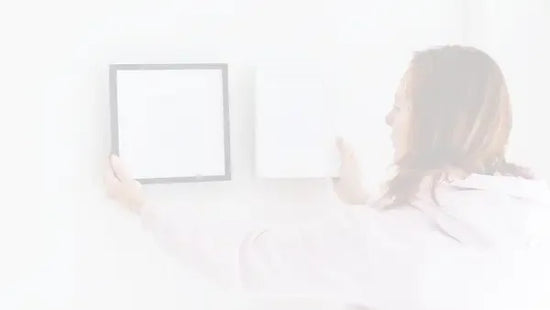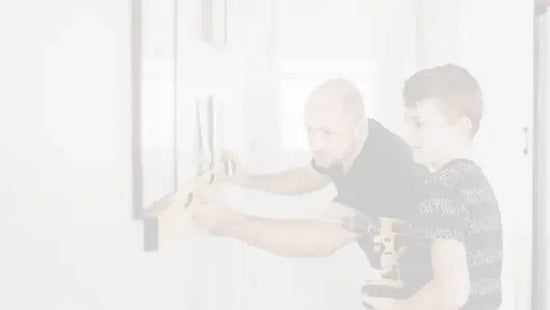Have you ever been torn between two similar products, both having the same purpose, but not quite the same? When shopping for our picture hanging needs, this can be quite a familiar feeling.
This is especially true for our picture screw category, where the crowd favorites are the bear claw screw and the wall dog screw.
You might think, “A screw is a screw. What could make them that different from each other?”
But for these two screws, there actually are quite a few essential differences, and in picture hanging, these differences can make or break a successful project.
In this comparison guide, you’ll learn about these important details, not only what differentiates the bear claw from the wall dog, but their similarities and features unique to each, as well as how to install them.
Let’s begin!
Table of contents
Why choose between picture hanging screws with care?
Picture screws are about half of the picture hanging process—after installing a hanger on your frame or item, the last step is mounting it on a nail, screw, or hook on the wall.

If nails and hooks are, for some reason or other, not an option for you, then screws are also an excellent choice of picture hanging hardware. But finding the right screw requires a more thorough approach than most people expect. In order to avoid damage to your wall and pictures, you need to match a screw with your item’s weight, frame hardware, and of course, the type of wall you will be puncturing with it.
So, what is a bear claw screw and a wall dog screw?
Bear claw screw hangers are double-headed anchorless screws used primarily on drywall. The double head on a bear claw screw features a small neck that is designed to fit virtually any keyhole hanger or cutout.

On the other hand, wall dog screws are versatile picture hanging screws with a special heat-treated tip for puncturing metal and wood.
Both screw hangers are easy to install and compatible with a wide range of wall substrates.
Let’s take a closer look at these two hardware solutions side by side.
Bear Claw Screw vs. Wall Dog Screw
In this guide, we will compare the bear claw screw and the wall dog screw in three categories: basics, technical specs, and practical factors.
Comparing the basics
The basic aspects to look at first are those we should consider when choosing any hanging hardware, the ones we mentioned earlier: weight rating, frame hardware or material, and wall type .
A hardware’s weight capacity or weight rating is the most crucial factor when hanging a piece of art or any wall decor. Knowing how much your frame weighs and choosing a hanger with a matching weight capacity is half the success in picture hanging.
A bear claw screw is rated at 30 lbs out of the box, but when assisted by a wall anchor or installed on a wood stud, then its weight capacity shoots to 100 lbs. This underlines the advantage of additional support. On the other hand, a wall dog screw can support double the bear claw screw’s capacity at 200 lbs, but only on concrete walls. On drywall, it can also support more than the bear claw at as much as 50 lbs.
Overall, the wall dog concrete screw is more of a heavy lifter, however, weight capacity is only the first thing to consider.

Screws, which are your wall hardware, work together with picture hangers, or your frame hardware, so we can hang frames safely. If the screw is not compatible with the hanger on your frame, it can lead to hardware damage and you might risk your pictures falling off.
Both bear claw screws and wall dog screws work with a variety of hangers, but some hangers are ideal. Bear claw screws are best with sawtooth hangers, but they are also an excellent choice for D-rings, euro hangers, and picture wire. Wall dog screws are most popular as a one-step fastener for French cleats, and they also work well with steel utility hooks.
As for wall type, both screws are compatible with a wide range. Bear claw screws, which are self drilling screws, are primarily for drywall, and you can make the most of wall dog screws on concrete walls and other hard surfaces.
We’ve listed all the wall types each screw is a match for in the table below, but in general, wall dog screws are a great choice for any type of wall substrate. It’s important to note that your wall type and a hanger’s weight capacity are essential to each other—often the former will decide the latter.

Read more about these three critical considerations in this guide:
Comparing technical specifications
Outside of wall type, weight capacity, and frame hardware, there are secondary technical aspects to consider too. Let’s compare how these look for the bear claw screw and the wall dog screw.
Both screws are about the same size, penetrating exactly an inch into a wall substrate. Bear claw screws come in two colors, gold and black, while wall dog screws come in standard aluminum/silver.
Both screws are sold in 10-packs and in bulk 100-packs and 1000-packs.

Another thing these screws have in common is a special design with their tips. The bear claw hanger has a notable self-drilling tip, which means in most cases, you don’t have to use a wall anchor with it or drill a pilot hole (we’ll discuss this more in the next section). This drywall screw is also designed specifically so it fits into any standard keyhole or cutout.
As for the wall dog screw’s special feature, a wall dog concrete screw is non-combustible because of its special heat-treated point. This makes it more effective in piercing hard substrates in much less time and effort than other hardware.

Comparing practical factors
Now that we’ve focused on the screws themselves, it’s time to assess the most important empirical points when putting the bear claw screw and the wall dog screw to use and compare them side by side.
First: do we need to drill a pilot hole to install these screws on the wall? The answer is no—generally.
Both screws do not need pilot holes for drywall and most other wall types, but when installing on hard substrates, a pre-drilled hole is requisite for both screws. Note the sizes of each respective hanger’s pilot hole in the table guide below.
Another important question is—does each screw need a wall anchor for installation?
Thanks to its heat-treated tip, the wall dog screw is a screw and an anchor in one and possesses a stronger weight rating as a result, so it doesn’t need a wall anchor. The bear claw drywall screw can also do without a wall anchor, but only if your item or frame is no heavier than 30 lbs—for anything heavier, a wall anchor or wood stud is a must.

From everything we’ve covered so far, we can discern the bear claw screw and the wall dog screw’s best uses. Both screws are excellent choices for hanging light to medium weight art and decor. The bear claw screw is a convenient solution for items that have keyhole cutouts and hangers, such as wall clocks. The wall dog screw, on the other hand, is reliable for heavier applications, including shelves, mirrors, and as wall hardware for French cleats.
When it comes to the actual installation process, both the bear claw screw (aka self drilling screws) and the wall dog screw are easy and straightforward to install using a Phillips screwdriver. Read on for a step-by-step guide to installing each screw on your wall.

How to install
To install a bear claw screw, follow these steps:
- On the wall, mark the position where you’d like to install the screw.
- Drill a 1/8" pilot hole if your wall is concrete, brick, or masonry. For drywall and other wall types, skip to step 3.
- Install a wall anchor if your frame is over 30 lbs. or if not installing on wood stud.
- Drive the bear claw screw into the wall using a screwdriver.
- Hang your frame.
To install a wall dog screw, refer to the following steps:
- On the wall, mark the position where you’d like to install the screw.
- Drill a 3/16” pilot hole if your wall is a plaster wall, brick, or concrete. Skip to step 3 if your wall type is none of these.
- Drive the wall dog screw directly into drywall, metal, or wooden substrates using a screwdriver.
- Hang your frame.
There is a lot more to picture screws beyond the two we’ve discussed in this article. Check out our guide to everything picture screws:
Final thoughts
Picture screws don’t seem like the most unique hanging tools, but they’re actually quite different from each other, and their differences make picture hanging a more satisfying experience—the bear claw screw and the wall dog screw are proof of this.
What did we miss about these two screws that you wanted to know about? Let us know in the comments below!








Leave a comment (all fields required)